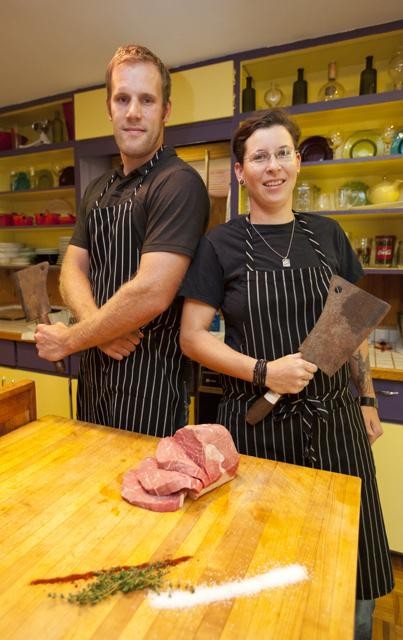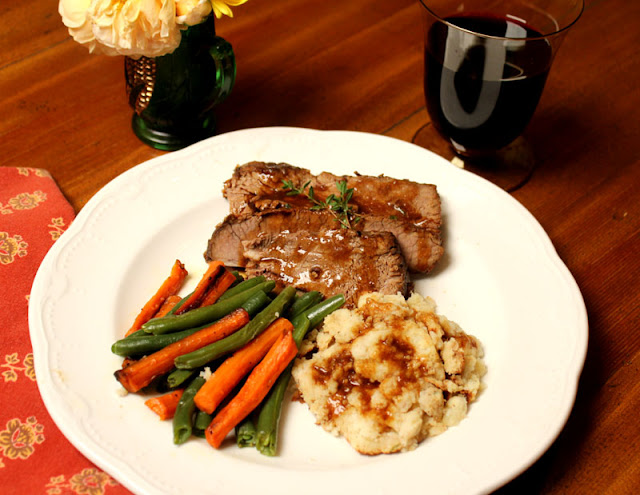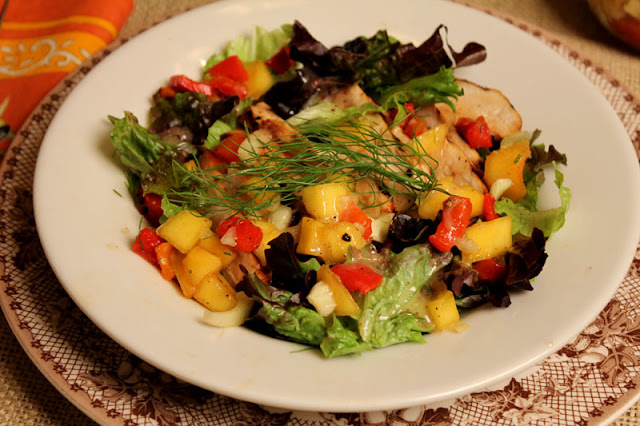This salad is a last hurrah to Summer. It showcases the late peaches of the season and an organic fennel bulb that I picked up at the market. With those I made a peach salsa to garnish my grilled chicken and salad greens.
The salsa also includes roasted red peppers and onions. It made enough to have on hand for other uses over the next few days.
The inspiration for this dish came from a wonderful new cookbook that I purchased last month. One of my favorite restaurants in Asheville, NC is The Tupelo Honey Cafe.
The name Tupelo Honey comes from a special honey produced by bees that get their nectar from a rare tupelo tree that grows in the river basins of NW Florida. It has a distinct flavor and changes slightly from year to year. The Tupelo Honey Cafe also has a distinct flavor. It is a reflection of the new South where grits become grits with goat cheese and fried chicken becomes nutty fried chicken with sweet potato mash. The plain biscuit becomes a ginormous biscuit with tomato shallot gravy and a BLT becomes a southern fried chicken BLT. These are just a few of the riffs on Southern classics that are served at The Tupelo Honey Cafe. Chef Brian Sonoskus and co-author Elizabeth Sims have recently come out with The Tupelo Honey Cafe Cookbook.

I love the unique recipes in this book. I also love the concept behind the recipes. One of the first chapters is “The Larder”. These recipes are for salsas, gravies, sauces, dressings, spreads and preserves. They are the keys to the great flavors that make all of the recipes shine.
The peach fennel salsa gives this salad a kick, but the homemade pecan vinaigrette is also the perfect addition to the whole flavor profile.
The chicken is marinated in pineapple juice, olive oil, soy sauce, garlic and ginger before it is sauteed on a grill pan. There are 4 recipes to follow to bring the whole dish together. But it is so worth the time that it takes because, once it is prepped, it can all be pulled together at the last minute. It reminds me of a restaurant kitchen where each component is made ahead and ready to go for the final flourish and presentation. I love this concept. Next I will try the Sweet Potato Pancakes with Peach Butter and Spiced Pecans. See what I mean?
PEACHY GRILLED CHICKEN SALAD WITH PECAN VINAIGRETTE
For the Chicken:
3 to 4 boneless chicken breasts
3/4 cup pineapple juice
1/3 cup olive oil
1/3 cup low-sodium soy sauce
2 cloves garlic, finely chopped
1 tablespoon finely minced fresh ginger
Combine pineapple juice, olive oil, soy sauce, garlic and ginger. Add chicken breast and marinate in fridge for 2 to 4 hours. Remove from marinade and saute on a preheated ridged grill pan or in an iron skillet turning once until cooked through. about 4 minutes per side. Transfer the chicken to a cutting board, let rest and then slice thinly.
For the Peach Fennel Salsa:
1/2 cup diced fresh fennel (bulb, stalk, and feathery leaves, tough outer layer discarded)
2 cups peeled and diced peaches (about 4 peaches)
1 cup diced roasted red bell pepper (I used the jarred variety)
1/2 cup diced red onion
4 teaspoons roasted garlic oil (I cooked 4 whole garlic cloves in 1/4 cup olive oil for about 20 minutes)
1/8 teaspoon sea salt
1/8 teaspoon freshly ground black pepper
Combine the fennel, peaches, bell peppers, onion, garlic oil, salt and pepper in a large bowl. Refrigerate in an airtight container for at least 30 minutes. The salsa can be kept refrigerated for 2 days.
For the Pecan Vinaigrette:
1/4 cup pecans
1/4 cup cider vinegar
1 clove garlic, minced
2 1/2 teaspoons Dijon mustard
2 1/2 teaspoons whole-grain mustard
1 tablespoon plus 1 1/2 teaspoons tupelo honey (or what you have)
2 teaspoons sugar
1 teaspoon sea salt
1 teaspoon freshly ground black pepper
1 cup canola oil
1/4 cup extra-virgin olive oil
Pulling it All Together:
Place salad greens in individual bowls. Top with chicken slices and salsa. Serve with the vinaigrette drizzled over the top. Garnish with a fennel frond if desired.
Printable recipe

















